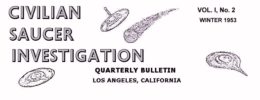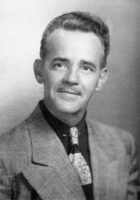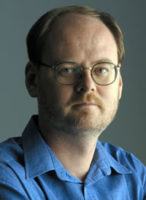By Charles Lear
 What was the first civilian organization solely dedicated to research on the subject of UFOs and when did they form? After a little research, most should agree that it was the Los Angeles based Civilian Saucer Investigation formed in 1951. What may surprise many is that there was a group interested in all things paranormal that was looking at aerial phenomena reports even before the June 24, 1947 Kenneth Arnold sighting. What may be equally surprising is the longevity of the organization, which started in 1945 and is still represented by an active website today.
What was the first civilian organization solely dedicated to research on the subject of UFOs and when did they form? After a little research, most should agree that it was the Los Angeles based Civilian Saucer Investigation formed in 1951. What may surprise many is that there was a group interested in all things paranormal that was looking at aerial phenomena reports even before the June 24, 1947 Kenneth Arnold sighting. What may be equally surprising is the longevity of the organization, which started in 1945 and is still represented by an active website today.
Borderland Sciences Research Associates was formed in San Diego, California in 1945 by Meade Layne along with fellow intellectuals interested in exploring subjects that lay between the realms of spiritualism and science. Layne was an academic with a masters in English who supported his family as a teacher, taking jobs across the country. In the course of his career, he was the English Department Head at Illinois Wesleyan University and Florida Southern College and a professor at the University of Southern California. Prior to his involvement with BSRA he had contributed various writings and research papers to journals devoted to parapsychology, spiritualism and the occult. As soon as the group was formed they published their own monthly newsletter, the Round Robin, and Layne was the editorial director. The subjects that were written about covered the range of what can be best described as “Western esotericism.”
In the January, 1946 issue we get the first story of interest for UFO historians. In an article titled, “Do You Hear Voices?” the writer addresses the “Shaver Mystery” which involved a man who heard voices while welding and believed them to be from degenerated humanoids living underground who flew through tunnels in technically advanced vehicles. These vehicles were later thought by some to be responsible for Arnold’s sighting and those that followed. This was likely due, in large part, to the influence of the men responsible for the mystery: writer, Richard Shaver and publisher, Ray Palmer. What may be of equal interest to UFO enthusiasts are comments taken from a letter in that same issue regarding ball lightning and “will-o’-the-wisps” mentioning marsh gas being a common prosaic explanation offered for strange lights.
In the October, 1946 issue, there is a UFO report of an object seen by one of the BSRA founding members, Mark Probert along with a young neighbor boy while watching meteors from a San Diego rooftop. Meade Layne wrote that Probert had called him at 7:45 PM on October 9th, and included Probert’s statement along with an additional comment from the boy, Fernando Estevane. Layne then wrote that more calls were received the following night descibing similar objects and he related the reports of 12 witnesses giving initials for ten and full names for two. This is Probert’s report:
“This object was about the size of an extremely large plane, and carried two reddish lights. At first it was moving with extraordinary speed, faster than any plane. I saw it twice. The second time it crossed the face of the moon, and the flapping of its wings was plainly visible. The whole object seemed somewhat luminous.”
Because the phrase, “flying saucer” had yet to be coined, a name was required for the object and the name “Kareeta” was given to it after Probert received it in a trance from an unnamed “communicator.” The communicator imparted that the Kareeta was from a far-off planet thousands of miles away. This was one of the practices of BSRA that will be detailed further on.
In the November issue, Layne wrote a follow up article titled, “Kareeta Business.” In it, Layne showed a sense of humor and objectivity that struck this writer as being quite modern. Referring to the information received through Probert’s trance, Layne wrote,
“But be it known, we don’t accept everything we are told, from any source, even by newspapers, and we do not guarantee anything, whether from AP, UP, or Station Astral.”
He clarified that it was the communicator that said the Kareeta was a space ship, that it was unknown whether it would return or not and added, “if they don’t, well maybe one close-up look at this planet was all the K-people could stand.”
 UFOs were now a regular subject of discussion for BSRA and the group was primed for the flying saucer invasion soon to come. In the July & August 1947 issue of Round Robin, an article titled, “Fly, Lokas, Fly!” opens with a description of Arnold’s June 24, sighting being reported on California radio stations on June 26, two days later. A July 7, 1947 photo (the “Rhodes Photo” taken in Phoenix, Arizona) of what seems to be a craft similar to those reported by Arnold is included along with other reported sightings. One that stands out is a sighting by an “engineer” in Joliet, Illinoise, of nine objects in formation that “flipped and righted themselves in unison, as if all were powered from the leading disk or were in tow.” Following the sightings descriptions is a discussion which includes a description of the ridicule and a critisism of the explanations offered for the sightings that foreshadows the writings of investigators soon to come such as Donald Keyhoe and Frank Edwards. Unique to BSRA was the practice of looking for answers to the mystery through intellectual discussion during seances conducted by Probert with an ethereal group of characters (communicators) called, “Controls” that were known as “the inner circle.” One of the Controls came through under the name of Charles Lingford and Lingford’s explanation for the sightings is included in the article.
UFOs were now a regular subject of discussion for BSRA and the group was primed for the flying saucer invasion soon to come. In the July & August 1947 issue of Round Robin, an article titled, “Fly, Lokas, Fly!” opens with a description of Arnold’s June 24, sighting being reported on California radio stations on June 26, two days later. A July 7, 1947 photo (the “Rhodes Photo” taken in Phoenix, Arizona) of what seems to be a craft similar to those reported by Arnold is included along with other reported sightings. One that stands out is a sighting by an “engineer” in Joliet, Illinoise, of nine objects in formation that “flipped and righted themselves in unison, as if all were powered from the leading disk or were in tow.” Following the sightings descriptions is a discussion which includes a description of the ridicule and a critisism of the explanations offered for the sightings that foreshadows the writings of investigators soon to come such as Donald Keyhoe and Frank Edwards. Unique to BSRA was the practice of looking for answers to the mystery through intellectual discussion during seances conducted by Probert with an ethereal group of characters (communicators) called, “Controls” that were known as “the inner circle.” One of the Controls came through under the name of Charles Lingford and Lingford’s explanation for the sightings is included in the article.
The Lingford explanation was that there are “worlds within worlds” termed, “etheric” that “interpenetrate” with our world and each other. The saucers and their creators were not interplanetary but “etheric.” Layne would further this view in a booklet published in 1950 titled, “The Ether Ship Mystery and Its Solution: A Booklet for Public Information.” Here was the “interdimensional hypothesis” often credited to John Keel who coined the phrase, “ultraterrestrials” in his 1970 book, “Operation Trojan Horse.” Keel would refine his ideas in his 1975 book, “The Eighth Tower” but here were similar ideas in the Round Robin more than 20 years earlier.
In 1959, Riley Hansard Crabb took over as director (he paid Layne $1200 who insisted on selling it as a business even though the organization had been a non-profit since 1951) and while the journal still covered all things esoteric, Crabb was particularly interested in flying saucers. Crabb continued to include Probert and his inner circle as part of the research and believed in the “etheric” origin theory. Also writing on the subject was fellow associate, Trevor James Constable who became best known in the UFO community for his theory that the phenomenon could be explained as giant amoeba-like creatures that lived in Earth’s atmosphere. Crabb was director until 1985, when he moved to New Zealand after the death of his wife, Judith. Judith played a significant role in keeping the group afloat during the change in leadership and was a contributing writer for the journal. The journal continued under various editors and various names until 2004, and moved away from UFO discussion. In 2000, James Borges, who presently oversees the organization, took over as editor.
 The journals that were published since 1945 are a valuable resource for UFO historians and investigators and many of the articles that were contained therein are available online. Hard copies of many of the group’s publications are also available for sale on the website. In 2016 Clas Svan, of the Swedish based Archives For the Unexplained, got in touch with Borges and convinced him that the BSRA archives could best be preserved in
The journals that were published since 1945 are a valuable resource for UFO historians and investigators and many of the articles that were contained therein are available online. Hard copies of many of the group’s publications are also available for sale on the website. In 2016 Clas Svan, of the Swedish based Archives For the Unexplained, got in touch with Borges and convinced him that the BSRA archives could best be preserved in
Sweden. Svan traveled to Eureka, Califonia with his son and they prepared 72 boxes for shipment. For those who can’t make the trip to Sweden, the BSRA website provides a fascinating glimpse into a realm of philosophical exploration that has its roots in the writings of the theosophists, early twentieth century esotericists and particularly Charles Fort who published a series of books devoted to subjects that he describe as “the damned” meaning they were damned by science. The roots of paranormal investigation are deep indeed.